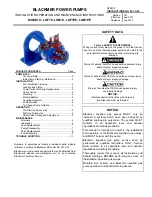
- 21 -
1. Troubleshooting
If you find any abnormality on the pump, stop the pump immediately and inspect the pump according to
following procedure.
Trouble
Cause
Countermeasure
Pump does
not discharge
liquid.
Motor does not
rotate.
● Disconnected wires.
● Failed motor
● Check fuse wiring.
● Repair or replacement
Pump does not
rotate.
● Rubbing parts stick or are
broken.
● Frozen pump
● Repair or replace.
● Warm pump.
Both motor and
pump rotate.
● Lack of priming water.
● Air gets in suction pipe.
● Excessive total head compared
to pump available performance.
● Prime pump again.
● Correct suction piping.
● Use the pump of higher total
head ability or reduce the
required total head.
Liquid is not kept
in pump during it
is stopped.
● Failed or wrongly mounted built-
in check valve
● Repair or replace.
Flow rate is
not enough.
● Air gets in suction pipe.
● Worn impeller.
● Reduced rpm due to drop of
power voltage.
● Correct suction piping.
● Repair or replace.
● Check voltage and take
measure.
Motor is
overheated.
● Voltage is reduced.
● Overload
● Too high ambient temperatures.
● Check voltage and take
measure.
● Check if voltage and frequency
are correct.
● Check if specific gravity or
viscosity of liquid is within
allowable limit.
● Check if bearing is not locked or
if motor fan rotates smoothly.
● Ventilate the operation site.
Pump
vibrates.
● Installation foundation is not
perfect.
● Loosened mounting bolts.
● Clogged suction pipe or
cavitation occurs.
● Pump bearing is worn or melted.
● Damaged magnet capsule or
spindle.
● Drive magnet is not balanced.
● Impeller or magnet capsule
touches other part.
● Worn motor bearing.
● Correct foundation and
mounting.
● Tighten.
● Clean or settle reason of
cavitation.
● Replace
● Replace
● Replace
● Replace
● Replace bearing or motor










































